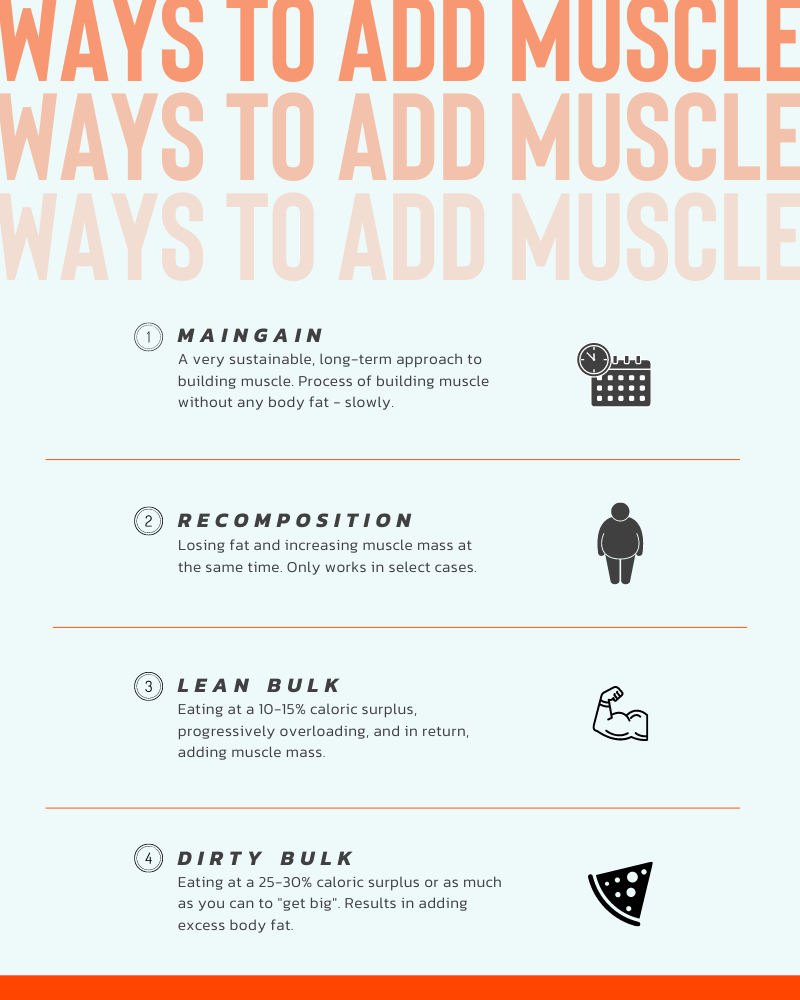How to Lean Bulk
 You’ve just received a magic lamp. Congrats! Rub it three times, and you can choose one of two wishes:
You’ve just received a magic lamp. Congrats! Rub it three times, and you can choose one of two wishes:
1. Gain muscle without adding any body fat. You just train, eat, and slabs of muscle layer onto your body. You don’t have to eat outrageous amounts of food and the muscle keeps packing on.
2. Lose body fat without any loss of muscle. You just train, eat, and fat melts off of your body with all your muscles underneath intact. You don’t have to restrict your food in any way.
Does this sound great, but a little unrealistic? Lean bulking may be more doable than you think if you have the secret ingredient: time.
The Limits of Bulking and Cutting
Here’s how most people go about changing their body:
Decide to go all in on short term change. The diet starts NOW.
Push to the extremes of diet and training in order to accelerate the process. No days off!
Dramatic calorie restriction or surplus leads to dramatic change. Sweet! But the faster you gain muscle, the more extra fat comes with it. And losing fat quickly means losing extra muscle too.
To compensate, the bulkers go on a cut and the cutters go on a bulk. Or they quit altogether because they’re miserable from living on extreme calorie and training routines.
Other Ways to Add Muscle

Well what about recomposition?
It is possible to lose fat and increase muscle mass at the same time. This is like GOLD. If we could do this for everyone it would be amazing. But the truth is, it only works in a select few cases. Mostly those who are very overweight, highly out of shape, and haven’t done resistance training in a while, or ever. However, these folks can recomposition on a slight calorie deficit or sometimes at maintenance calories. Consider this newbie gains.
How about a lean bulk?
This means eating at 10-15% above maintenance calories. Train hard with progressive overload and in return, add muscle mass. Along with that muscle comes a small amount of body fat. In a lean bulk, the idea is to eat just enough in a surplus to promote muscle growth. But not so much that you add too much excess body fat.
Lean bulkers usually do mini-cuts or cuts every so often to burn extra body fat from the process. These cuts don’t need to last as long as traditional cuts if you’re mindful not to gain too much body fat. This has been the preferred method in the past decade to bulk. Science has proven that even at this level of a calorie surplus, you can get fairly close to maxing out your muscle growth. There are only marginal benefits, if any, to eating in a greater surplus of calories.
Contrast this with the dirty bulk.
This is eating in a calorie surplus of 25-30% or even more. You gotta eat big to get big!” This gave rise to bodybuilders eating as much as they could to put on more muscle. Sadly, this comes with a ton of extra body fat.
The “dirty” part of this style of bulking refers to junk food calories. It’s difficult to eat at a large surplus on whole unprocessed foods. So dirty bulking usually comes with high calorie foods that might not make you feel the best.
Unfortunately, you will not gain significantly more muscle mass than a lean bulk to warrant all the extra body fat. It will take a long time of dieting to get the fat to come off.
Time to MAINGAIN
 When people are new to fitness, they usually enjoy some recomposition or newbie gains in the first months. If they go further down the rabbit hole, they usually opt for a bulk or a cut.
When people are new to fitness, they usually enjoy some recomposition or newbie gains in the first months. If they go further down the rabbit hole, they usually opt for a bulk or a cut.
But at a certain point, the bulking and cutting yo-yo loses its appeal. When you’re ready for a very sustainable, long-term approach to building muscle, MAINGAINING may be for you.
This is the process of building muscle without any body fat – slowly. You keep the same body composition, eat at Maintenance calories, and train hard with progressive overload. In theory, you can build muscle very slowly (think years, not months or weeks).
You would first want to be at a body composition you are happy with. This is not a process of dramatically changing body composition levels. You are satisfied and ready to play the slow and steady game of adding muscle without body fat.
Do I Need to Cut Calories to Show Muscle?
 The idea with maingaining is that you don’t go through periods of bulking and cutting. You simply stick to maintenance calories indefinitely. That number might change with your lifestyle and activity level. So you might need to adjust the calories at some point, but only to keep you at maintenance.
The idea with maingaining is that you don’t go through periods of bulking and cutting. You simply stick to maintenance calories indefinitely. That number might change with your lifestyle and activity level. So you might need to adjust the calories at some point, but only to keep you at maintenance.
If you train hard with progressive overload, you slowly build some muscle over time. If you do this correctly, you can maintain the same level of leanness while adding muscle year after year.
Who is MAINGAINING for?
Let’s begin with who should NOT go the maingaining route:
If you want to build lots of muscle quickly, this isn’t the way.
If you are still in the first couple years of your lifting journey and want to make significant changes to your body. You have some lean bulking, cutting, or in some cases, recomposition to do.
Who should consider maingaining?
If you are not a bodybuilder and don’t care about max gains (that is me at this stage of life)
If you struggle with doing cuts
If you struggle with bulking getting out of hand
If you don’t have a hard time progressing your gym performance
Who is PERFECT for maingaining:
Are you on the tail end of a long lifting career? Have you already gone through dramatic changes to your body in years or decades past? You’re primed for maingaining magic. Eat at maintenance, and allow your hard training to help slowly develop and sharpen your physique over time.
What’s the Best Training Approach to Maingain?
 Any resistance training style that places high demands on your body. Remember that your diet won’t promote an anabolic (muscle-building) environment from surplus calories. The muscle growth signals have to come from hard training. Imposing a lot of demands on your body to adapt and grow is KEY.
Any resistance training style that places high demands on your body. Remember that your diet won’t promote an anabolic (muscle-building) environment from surplus calories. The muscle growth signals have to come from hard training. Imposing a lot of demands on your body to adapt and grow is KEY.
So long as you are lifting weights and training harder than last time, you can do what you love. CrossFit, Bodybuilding, Functional Bodybuilding, or even things like Powerlifting and Olympic Lifting.
Fluxing – it’s also important to consider where your maintenance baseline is. Let’s say you eat 2000 calories at maintenance. And you burn 2000 calories from all forms of energy output including training. It will be harder to maingain than someone at the 4000 calorie level. The 4000 calorie person will be doing a lot more training and activity, thus placing a much greater demand on the muscles to grow. In other words, more activity and more calories works better, assuming these balance out to maintenance.
Should You Limit Cardio?
 I don’t think this is necessary. You have to pick the type of training you love to do. If you like cardio then keep doing it. Keep doing whatever will keep you inspired to come into the gym and push hard in your training with progressive overload.
I don’t think this is necessary. You have to pick the type of training you love to do. If you like cardio then keep doing it. Keep doing whatever will keep you inspired to come into the gym and push hard in your training with progressive overload.
Since Maingaining builds muscle slowly over time, you will need to resistance train. You cannot just do cardio for this. You just don’t have to stop your cardio.
How Do You Figure Out Your Macros?
You can use a macro calculator like our free one. Input your activity level and body metrics, and then use the maintenance calories. I suggest sticking to the 1 gram of protein per pound of body weight approach. Fill the rest in with no less than 40% of your calories from carbs and the rest from fats.
This would be our moderate approach to carbs on the FBB macro calculator. Carbs are very important to help push the training intensity required for maingaining.
Is This Like Reverse Dieting?
Reverse dieting is a different topic, but there is some overlap from a psychological perspective. Reverse dieting is a process of coming out of a habitual calorie deficit. People who have been under eating for a long time feel terrible and stop seeing results in a metabolic slowdown. They slowly add back calories and reverse out of their deficit to get their metabolic engine fired up again and regain their vitality.
Switching to maingaining helps when you’re mentally exhausted from bulking and cutting time and time again. Like reverse dieting, it can be a tool to overcome the psychological exhaustion of the traditional bulk and cut culture.
Remember the Magic Ingredient
 No matter which approach you choose, remember that strength and physique are life long pursuits. A bulk or a cut can be great for the short term. And there are also sustainable approaches that can help you look good and move well for decades.
No matter which approach you choose, remember that strength and physique are life long pursuits. A bulk or a cut can be great for the short term. And there are also sustainable approaches that can help you look good and move well for decades.
If you’ve been burned by the yo-yo cycle, you don’t have to throw in the towel. Maingaining puts the power of time on your side. Train hard, stay consistent, and you will be rewarded.
More Resources

Look Good. Move Well.
Workouts for sculpted arms and a six pack are different than those for speed and power. Get my blend of both and a sample nutrition plan. Plus a Big Bicep Bonus for my favorite arm finishers!
